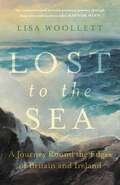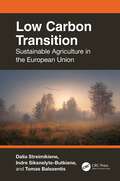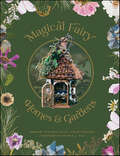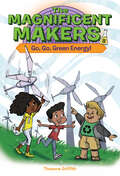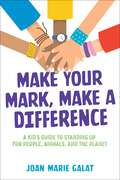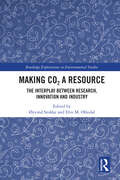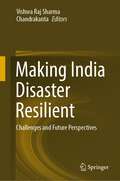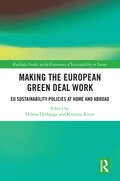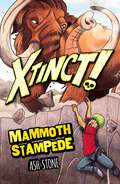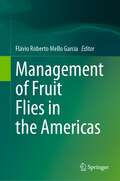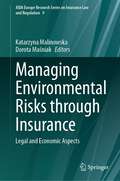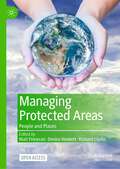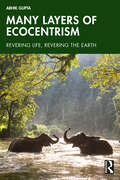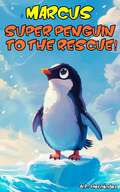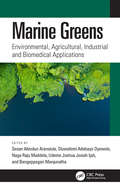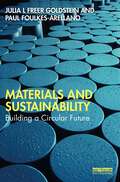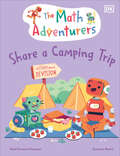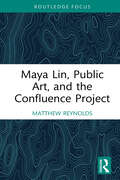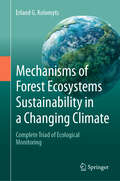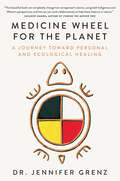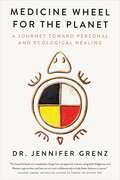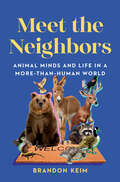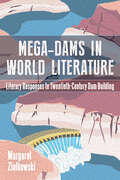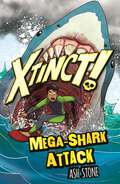- Table View
- List View
Lost to the Sea: A Journey Round the Edges of Britain and Ireland
by Lisa Woollett'An immersive and lyrically personal journey through deep-time and modern tides' RAYNOR WINN'Wondrous, elegant and haunting, Lost to the Sea is a fascinating alternative history of the fractured, flooded and eroded edges of Britain and Ireland' PHILIP HOAREMedieval kingdoms. Notorious pirate towns. Drowned churches. Crocodile-infested swamps.On a series of coastal walks, Lisa Woollett takes us on an illuminating journey, bringing to life the places where mythology and reality meet at the very edges of Britain and Ireland.From Bronze Age settlements on the Isles of Scilly and submerged prehistoric forests in Wales, to a Victorian amusement park on the Isle of Wight and castles in the air off County Clare, Lisa draws together archaeology, meetings with locals and tales from folklore to reveal how the sea has forged, shaped and often overwhelmed these landscapes and communities.Lost to the Sea is an exhilarating voyage around the ever-shifting shores of the British Isles, and a haunting ode to our profound relationship with the sea.'A hugely enjoyable mosaic of history, myth and imagination' SARA WHEELER'Beautifully written and researched . . . I was immediately tempted to head out in search of lost lands' WYL MENMUIR
Low Carbon Transition: Sustainable Agriculture in the European Union
by Dalia Streimikiene Indre Siksnelyte-Butkiene Tomas BalezentisLow-carbon transition is a shift from an economy that depends heavily on fossil fuels to a sustainable, low-carbon energy economy. This book analyzes the role of renewables in driving the low-carbon transition in agriculture, explores the circular bio-based economy, and examines policies and strategies designed to facilitate low-carbon transition in agriculture, greenhouse gas mitigation, and adaptation trends in the European Union agriculture sector. It provides new knowledge and understanding about the impact of low-carbon energy transition, emphasizes the key role of renewable energy in a wide range of agricultural activities, and offers alternative sustainable solutions to current practices.Features Discusses a novel approach on low-carbon transition that is not considered by the majority of studies Emphasizes the urgent need to minimize the carbon and environmental footprint of the EU agriculture and food system through low-carbon energy transition Provides theoretical background of sustainable agriculture and explains the decarbonization path of agriculture. Investigates the role of renewables, new technologies, business models, and practices in agriculture while assessing their socioeconomic and environmental effects. Presents a case study on the applications of low-carbon transition policies in selected EU member states and analyses in details various implications. This book is suitable for senior undergraduate and graduate students, professionals in agriculture, researchers, and policy makers interested in sustainable agriculture and renewable energy usage and their economics.
Magical Fairy Homes and Gardens
by Barbara Purchia E. Ashley RooneyFairies—those mythical sprites of folktales and daydreams—are an enduring source of fascination to humans. Designing, creating, and maintaining fairy dwellings and gardens has become popular as an artistic endeavor, family activity, or form of meditation. Published in 2014, Purchia and Rooney's Fairy Homes & Gardens has transported thousands of readers to the magical realm of fairy gardening. In the ensuing years, fairy homes and gardens have become much more than a fleeting trend, establishing a perennial pastime for people of all ages. A treasure trove of ideas, this inspiring follow-up features • images and stories of more than 50 new projects that encompass a wide variety of fairy dwellings—communities, cottages, houses, castles, chalets, and other serendipitous structures, • creations by more than two dozen of the most talented and innovative artists creating fairy environments, • a special chapter on fairy accessories, including furniture, doors, swings, and the other creature comforts that fairies appreciate, • an appendix spotlighting plants that are ideal for incorporation into fairy gardens, and • a foreword that tells the story of Florence Griswold Museum's wildly popular Wee Faerie Garden event. Appealing to fairy enthusiasts and nature lovers of all ages, this book provides bold inspiration to help readers embark on a creative and relaxing pursuit that takes them directly into the world of fairy magic.
The Magnificent Makers #8: Go, Go, Green Energy! (The Magnificent Makers #8)
by Theanne GriffithBoom! Snap! Whiz! Zap! The Magnificent Makers is a fiction chapter book series filled with real science, adventure, and characters kids will love! Every book includes two science activities kids can do at home.A modern-day Magic School Bus for today's kids!Pablo, Violet, and their classmate Garry are on a field trip to the Environmental Science Center when they are transported to the Maker Maze! In the maze, they&’ll work with wacky scientist Dr. Crisp to complete three challenges all about wind, solar, and tidal energy. But then Violet begins to feel bad about how much energy she&’s been using. Can she, Pablo, and Garry learn how to use energy in a way that doesn't hurt the earth? In Go, Go, Green Energy!, the kids learn the importance of being mindful and never giving up. Don&’t miss the other books in the series! #1: How to Test a Friendship#2: Brain Trouble#3: Riding Sound Waves#4: The Great Germ Hunt#5: Race Through Space#6: Storm Chasers#7: Human Body Adventure
Make Your Mark, Make a Difference: A Kid's Guide to Standing Up for People, Animals, and the Planet
by Joan Marie GalatTake the first steps into activism with this comprehensive middle grade guide that empowers readers to choose and become knowledgeable in a cause they are most passionate to reform, and to create meaningful change through learning what&’s already been accomplished—and what can still be done.Getting involved can be an overwhelming prospect, but this guide provides readers with tools to become informed and effective activists with an accessible approach offering hope and perspective. From Black Lives Matter and light pollution to climate change and healthcare equity for all, the book leads readers through an overview of issues, an essential human rights background, and stories of how other young activists tackle local, national, and international problems. Readers will discover a multitude of ways to build change and learn that every contribution matters.
Making CO2 a Resource: The Interplay Between Research, Innovation and Industry (Routledge Explorations in Environmental Studies)
by Elin M. Oftedal Øyvind StokkeThis interdisciplinary book explores how CO2 can become a resource instead of a waste and, as such, be a tool to meet one of the grandest challenges humanity is facing: climate change.Drawing on a Norwegian narrative that has significance for a global audience, Øyvind Stokke and Elin Oftedal introduce in-depth, multi-perspective analyses of a sustainable innovation research experiment in industrial carbon capture and utilisation technologies. Building on extensive literature within marine sciences, sustainability research, and environmental philosophy and ethics, this book documents how a misplaced resource like CO2 can become valuable within a circular economy in its own right, while at the same time meeting the challenge of food security in a world where food production is increasingly under pressure. The book is diverse in scope and includes chapters on how to reduce the environmental footprint of aquaculture by replacing wild fish and soy from the Amazon, how to optimise the monitoring of aquatic environments via smart technologies, and how to replace materials otherwise sourced from natural environments. The authors also analyse the pivotal role of the university in driving innovation and entrepreneurship, the pitfalls of different carbon technologies, and explore how the link between petroleum dependence and CO2 emissions has been addressed in Norway specifically.Making CO2 a Resource will be of great interest to students and scholars of climate change, environmental ethics, environmental philosophy, sustainable business and innovation, and sustainable development more broadly.
Making India Disaster Resilient: Challenges and Future Perspectives
by Vishwa Raj Sharma ChandrakantaVarious natural and man-made hazards are nowadays increasingly considered as disasters, particularly by individual and communities are lacking in awareness and where a system as a whole has no adequate management mechanism. Consequently, the world is facing serious negative outcome in form of loss of life, injury, disability, loss of property, infrastructure, and economic disruption followed by psycho-social disorders. Other than this, disasters adversely affect wildlife and environment in long terms. Developing countries are worst sufferers as these regions are poorly prepared for potential hazards at one hand and are exposed to disasters due to the complexity of (socio-cultural, economic and physical) vulnerability. Government, World communities, NGOs are recognizing the problems and are trying to build resilient communities to reduce disaster impact at various levels.Year 1990-99 was observed as the decade for natural disaster reduction by United Nations (UN) and United Nations International Strategy for Disaster Reduction (UNISDR) was established to support and coordinate this movement. Year 2015 has been very important in the history as three global agreements have been signed by global communities (Sustainable development goals, Paris agreement and Sendai framework for DRR). Where, SDGs are extension of MDGs to make the planet more sustainable. It proposed 17 goals and 15 years’ time frame adopted in the year 2015. SDGs target various social, cultural, economic, challenges followed by wildlife, environmental protection through knowledge share and technological innovation among all member countries. In December 2015, UNFCCC reached a landmark agreement to combat climate change and to accelerate and intensify the actions and investments needed for a sustainable low carbon future known as Paris agreement. Sendai Framework 2015 is voluntary, non-binding agreement which recognizes that the state has the primary role to reduce disasterrisk but that responsibility should be shared with other stakeholders including local government, the private sector and other stakeholders. This framework focuses on the pre-disaster management rather than post disaster relief and recovery. This book is an insight into the various issues related to the emerging disasters (both natural and man-made), vulnerable communities, and government initiatives taken with a geographical focus on India. This volume contains selected chapters written by faculty and research scholars. This book is an empirical work on disasters vulnerabilities and management which will benefit researchers, academicians, professional, practitioners and policy makers.
Making the European Green Deal Work: EU Sustainability Policies at Home and Abroad (Routledge Studies on the Governance of Sustainability in Europe)
by Helene Dyrhauge and Kristina KurzeThis book critically analyses different dimensions in the sustainable transitions outlined by the European Green Deal, focusing on both internal actions and external relations and highlighting the EU’s diverging powers and capabilities in achieving the core objectives. As with the Green Deal itself, the chapters cover different policies including financial instruments, energy policies, climate policies and external policies and apply the ideal-type logics of appropriateness and consequences to analyse sustainable transformations. The variety of the cases contribute to a broad understanding of how different actors interpret and implement the aims of the European Green Deal, including especially those lagging behind, who, for various reasons, are struggling with the sustainable transition. From examining their policies, the book illuminates the challenges and opportunities they are facing. Overall, the contributions address key questions surrounding the EU’s powers and limits in inducing transformative change and implementing the European Green Deal. This book will be of key interest to scholars, students and practitioners of EU sustainability policies, sustainability transitions and green economy, environmental studies, energy policy, energy governance and climate change, public policy, comparative politics and international relations.
Mammoth Stampede: Book 4 (Xtinct! #4)
by Ash StoneA giant woolly mammoth comes back to life in this action-packed adventure story.Time is running out! Barron Fox's hunting lodge is opening soon, and Jeevan discovers that he's planning a very big surprise for his guests - a woolly mammoth, brought back to life for them to hunt!If the lodge opens, the animals in the forest will be in danger too. Can Jeevan and his friends launch a daring rescue mission that tramples over Fox's plans?Perfect for fans of Beast Quest, Deadly 60 and Jurassic Park, these action-packed adventures will inspire readers to help save endangered species and combat extinction.
Management of Fruit Flies in the Americas
by Flávio Roberto Mello GarciaThis book comprises issues at the cutting edge of fruit fly management in the Americas, covering topics that are focal points of current activity and likely long-term importance to the progress of the field. The book is an invaluable source of ideas and inspiration for entomologists at all levels from graduate students to more-established researchers and professionals. Fruit flies (Diptera, Tephritidae) is the most important pests of fruit production worldwide. The purpose of this book is to integrate the experiences of leading scientists in the management of fruit flies in the Americas. In this work, species of fruit flies of economic importance are considered in the genera Anastrepha, Rhagoletis, Bactrocera, and Ceratitis. This book will address fruit flies monitoring, biological control, chemical control, cultural control, sterile insect technique (SIT), Integrated Pest Management (IPM), and other control methods. The book provides invaluable resource material to scientists, professionals and students.
Managing Environmental Risks through Insurance: Legal and Economic Aspects (AIDA Europe Research Series on Insurance Law and Regulation #9)
by Katarzyna Malinowska Dorota MaśniakThis book identifies the role of insurance in a comprehensive system for managing environmental risks at the local, regional and global level. National and international legal instruments regulating environmental protection, especially aspects like pollution, are not precisely reflected in insurance concepts intended to cover environmental risks. As such, there is a need to identify environmental risks and to propose a taxonomy of environmental risks for various types of insurance coverage. The authors refer to the issues of liability in environmental protection, the scope of insurance coverage and comment on specific issues the importance of which has been noticed by the legislator or insurance practice. The book examines these issues horizontally and vertically from various standpoints, focusing on insurance as a means of managing environmental risks. In this regard, it mainly concentrates on (1) identifying and analyzing environmental risks and methods for managing them via private and public instruments, and (2) insuring these risks. The book is intended for all those interested in the field of insurance and environmental risk regimes, including lawyers, academics and legal professionals.
Managing Protected Areas: People and Places
by Niall Finneran Denise Hewlett Richard ClarkeThis open access book brings together 16 specially commissioned chapters drawn from a range of different professional-practitioner and academic global perspectives on the importance of the relationship between people and green and blue spaces. It focuses on issues surrounding the importance of natural environments on public health and wellbeing, and the environmental, cultural, and social importance of green and blue spaces that can result through responsible and sustainable adaptive management processes. It explores how the Covid-19 pandemic forced reconsiderations of our relationship with these natural spaces and highlights the important impact of the pace of climate change. While not pretending to have the answers, the stimulating and imaginative contributions embrace rich perspectives drawn from backgrounds as diverse as heritage studies, tourism, conservation, geography, policy formulation, public health, environmental health, research methods, history, literature, art, and theology.
Many Layers of Ecocentrism: Revering Life, Revering the Earth
by Abhik GuptaThis book unveils the myriad streams of ecocentric thoughts that have been flowing through the human mind – in indigenous communities, in the wisdom of philosophers, in the creative expressions of poets and writers – sometimes latent, but sometimes more explicit. The strength of this book lies in the fact that it attempts to show that ecocentrism had not emerged suddenly as a distinct line of philosophical thought or found its place among the various normative approaches toward nature, but the seeds of ecocentrism had always been running through human societies. Thus, this book not only emphasizes the “unity of life” but also reveals the inherent unity of all hues of ecocentrism. The book adopts a multidisciplinary approach, which is essential to dwell on a topic like ecocentrism which permeates the domains of disciplines as disparate as science, philosophy, religion, normative ethics, myths and folklore, poetry, and literature, among others. Despite this eclectic approach, the book attempts to maintain continuity among the chapters and present these concepts in a simple form that will be easily accessible by readers from all conceivable backgrounds. This book would be useful to the students, researchers, and faculty from the fields of ecology and environmental science, philosophy, sociology, religious studies, and literature. It will also be an indispensable companion for all nature lovers, activists, and general readers interested in the emergence and evolution of environmental thoughts.
Marcus ... Super Penguin to the Rescue!: A refreshing story for boys and girls. Age 6 and up.
by A. P. HernándezMarcus is a young Emperor penguin. Like all his friends, Marcus has a very comfortable life at the South Pole. Everything is happiness and tranquility ... or is it? Read about his adventures! A moving story that teaches young readers the importance of caring for our planet and working together to meet the challenges of climate change. Containing numerous illustrations, this story will inspire children to become environmental advocates. An entertaining and educational read for the whole family! This book helps: •Encourage empathy, because children can put themselves in Marcus the Penguin’s feet, and learn to share their feelings throughout the story. •Stimulate the habit of reading through a simple story that captures readers’ attention from the very first page. •Inspire environmental action, motivating children to take measures to protect our planet. •Promote ecological awareness to understand the importance of conserving biodiversity. •Provide practical ideas on how to reduce environmental impact in everyday life, such as saving energy, reducing waste, and encouraging sustainable practices. •Empower children as agents of change, teaching them that individual involvement contributes positively to caring for the environment. What’s inside? •A fun story about a very brave penguin. •A book with beautiful illustrations that will make reading more enjoyable. •Written to develop vocabulary, this book assists language development.
Marine Greens: Environmental, Agricultural, Industrial and Biomedical Applications
by Sesan Abiodun Aransiola, Oluwafemi Adebayo Oyewole, Naga Raju Maddela, Udeme Joshua Josiah Ijah, and Bangeppagari ManjunathaThis book provides an in-depth overview of marine greens and their environmental and biotechnological applications. It addresses concepts such as the niche adaptation strategies of marine greens in their natural habitats, as well as their global distribution, and factors affecting their distribution and proliferation.Marine greens are posited as an alternative to fossil fuels, mitigating global climate change and thereby fostering future environmental sustainability. In addition, the book explains the remediation of xenobiotics, wastewater, microplastics, marine debris and marine green contamination. Expert authors from around the world explore the industrial and agricultural applications of marine greens in the production of enzymes and marine bioenergy, and what is needed to improve its production potential.This is important reading for government and non-governmental organizations as well as industries and research institutions looking for ways to combat current industrial and environmental challenges.
Marine Otter Conservation
by Liliana Ayala Raúl Sánchez-Scaglioni Gonzalo Medina-VogelThis book offers a multidisciplinary approach to conservation issues related to the marine otter (Lontra felina). The main goal is the systematization of different research efforts on this species, to contribute with conservation policy design and implementation. The authors contribute their achievements in conservation, ecology, status in freshwater habitats, habitat fragmentation effects, interaction with human activities and recommendations for an effective conservation of the species. The book is directed first and foremost towards researchers and authorities and people involved in conservation tasks of otters.Despite in the last decades some studies and efforts on Lontra felina has carried in Peru and Chile, some information can be gathered to fill the gaps on marine otter conservation in Peru. That is the main goal of the book Conservation of Marine Otter. Moreover, the publication will be the first book published at international level on Lontra felina with the participation of several experimented researchers on this threatened and endemic species.
Materials and Sustainability: Building a Circular Future
by Julia L Goldstein Paul Foulkes-ArellanoThis book examines sustainable manufacturing, from the extraction of materials to processing, use, and disposal, and argues that significant changes in all of the above are needed for the world to progress toward a more circular economy.Materials and processing methods are usually chosen with performance as the key metric. Why has our society embraced plastics? Because they work. In most cases, they are lighter, easier to manufacture, and less expensive than the metal, wood, glass, or stone they have replaced. Why do industrial manufacturers use toxic chemicals? Because they are effective, but the unintended consequences may be severe. By learning how various materials are made and what happens when they are recycled, readers will better understand the value of materials and the challenges that manufacturers face when trying to make their facilities and products less toxic and less wasteful. The three chapters in Part I provide essential background about materials in the circular economy, chemicals, and waste. Part II delves into specific materials. It includes chapters on plastics, metals, wood and paper products, glass, and novel materials. Part III covers recycling and manufacturing processes, and Part IV delves into practical considerations, including the effect of regulations, concluding with a chapter that helps readers translate the information presented into action. Interviews with industry experts round out the chapters and offer valuable insights.Materials and Sustainability is a must-read for business professionals who are serious about making their companies as environmentally responsible as possible and for business and engineering students who want to begin their careers with practical knowledge about materials and their impacts.
The Math Adventurers Share a Camping Trip: A Story About Division (The Math Adventurers)
by Sital Gorasia ChapmanJoin two friendly and funny robots, Beep and Boots, as they learn all about division and discover that math is everywhere they look.Beep and Boots are going on a camping trip in the great outdoors. They've got a warm sleeping bag each, a snuggly blanket each, and marshmallows to share. But they realize there are not enough tent pegs! Can they learn to divide up what they have and put up their tents before it's time for bed?Characterful illustrations and rhyming text bring Beep and Boots to life. Children ages 5-7 will love seeing the adventures the robot duo go on and will learn key mathematical concepts concerning division in a gentle, fun way. A visual glossary and math questions at the end of the book reinforce learning and encourage kids to look at the math they can see in the world around them.
Maya Lin, Public Art, and the Confluence Project (Routledge Focus on Art History and Visual Studies)
by Matthew ReynoldsThe first scholarly monograph devoted exclusively to this vital work of contemporary public art, this book examines Maya Lin’s Confluence Project through the lens of environmental humanities and Indigenous studies. Matthew Reynolds provides a detailed analysis of each earthwork, along with a discussion of the proposed final project at Celilo Falls near The Dalles, Oregon. The book assesses the artist’s longtime engagement with the region of the Pacific Northwest and explores the Confluence Project within Lin’s larger oeuvre. Several consistent themes and experiences are common amongst all the sites. These include an emphasis on individual, multisensory encounters with the earthworks and their surrounding contexts; sound as an experiential dimension of landscape; indexical accounts of the multicultural, multispecies histories of each place; and an evocation of loss. The book will be of interest to scholars working in art history, contemporary art, environmental studies, environmental humanities, and Native American studies.
Mechanisms of Forest Ecosystems Sustainability in a Changing Climate: Complete Triad of Ecological Monitoring
by Erland G. KolomytsThe author's working concept of geo-ecological monitoring is presented. For the first time, the full triad of monitoring in its classical definition is considered: "observation (state assessment) – control (prediction) – management (adaptation, feedback, regulation)". The strategic goal of described monitoring research is to reveal the environmental otential of sustainablility of forest ecosystems in the context of modern global warming. The monograph expounds the main statements of author’s topo-ecological predictive concept: “Global Changes on the Local Level”, as a basis of ground bio-ecological and geosystem monitoring of natural ecosystems under global anthropogenic climatic changes. This concept makes it possible to carry out local empirical simulation of the regional bioclimatic trend and thereby reveal the mechanisms of transmission of global and regional climate signals to the local level. On the example of the Volga River basin, predictive empirical-statistical models of the carbon balance of forest ecosytems are presented under conditions of a changing climate. The carbon content in various pools of boreal and nemoral forests were calculated. The global climate models give prognostic estimates of the components of them carbon balance. A quantitative assessment of the ecological resources of forest formations that provide the environment sustainability through mechanisms of regulation of the carbon cycle is given. The adaptation of forest ecosystems to climate change is described through the calculated parameters of their functional sustainability.
Medicine Wheel for the Planet: A Journey toward Personal and Ecological Healing
by Dr. Jennifer Grenz"This beautiful book can completely change how we approach science, using both Indigenous and Western perspectives, and how we can work collaboratively to help foster balance in nature." —Suzanne Simard, bestselling author of Finding the Mother TreeA farm kid at heart, and a Nlaka'pamux woman of mixed ancestry, Dr. Jennifer Grenz always felt a deep connection to the land. However, after nearly two decades of working as a restoration ecologist in the Pacific Northwest, she became frustrated that despite the best efforts of her colleagues and numerous volunteers, they weren't making the meaningful change needed for plant, animal and human communities to adapt to a warming climate. Restoration ecology is grounded in an idea that we must return the natural world to an untouched, pristine state, placing humans in a godlike role—a notion at odds with Indigenous histories of purposeful, reciprocal interaction with the environment. This disconnect sent Dr. Grenz on a personal journey of joining her head (Western science) and her heart (Indigenous worldview) to find a truer path toward ecological healing.In Medicine Wheel for the Planet, building on sacred stories, field observations and her own journey, Dr. Grenz invites readers to share in the teachings of the four directions of the medicine wheel: the North, which draws upon the knowledge and wisdom of elders; the East, where we let go of colonial narratives and see with fresh eyes; the South, where we apply new-old worldviews to envision a way forward; and the West, where a relational approach to land reconciliation is realized. Eloquent, inspiring and disruptive, Medicine Wheel for the Planet circles toward an argument that we need more than a singular worldview to protect the planet and make the significant changes we are running out of time for.
Medicine Wheel for the Planet: A Journey Toward Personal and Ecological Healing
by Jennifer GrenzA personal journey of bringing together Western science and Indigenous ecology to transform our understanding of the human role in healing our planetI used to be an ecologist. . . . Now, I am a community gatherer, working to help bring healing beyond just the land. I am a story-listener. I am a storyteller. I am a shaper of ecosystems. I work on bringing communities together, in circle, to listen to each other. A farm kid at heart, and a Nlaka&’pamux woman of mixed ancestry, Dr. Jennifer Grenz always felt a deep connection to the land. However, after nearly two decades of working as a restoration ecologist in the Pacific Northwest, she became frustrated that despite the best efforts of her colleagues and numerous volunteers, they weren&’t making the meaningful change needed for plant, animal, and human communities to adapt to a warming climate. Restoration ecology is grounded in an idea that we must return the natural world to an untouched, pristine state, placing humans in a godlike role—a notion at odds with Indigenous histories of purposeful, reciprocal interaction with the environment. This disconnect sent Dr. Grenz on a personal journey of joining her head (Western science) and her heart (Indigenous worldview) to find a truer path toward ecological healing. In Medicine Wheel for the Planet, building on sacred stories, field observations, and her own journey, Dr. Grenz invites readers to share in the teachings of the four directions of the medicine wheel: the North, which draws upon the knowledge and wisdom of elders; the East, where we let go of colonial narratives and see with fresh eyes; the South, where we apply new-old worldviews to envision a way forward; and the West, where a relational approach to land reconciliation is realized. Eloquent, inspiring, and disruptive, Medicine Wheel for the Planet circles around an argument that we need more than a singular worldview to protect the planet and make the significant changes we are running out of time for.
Meet the Neighbors: Animal Minds and Life in a More-than-Human World
by Brandon KeimWhat does the science of animal intelligence mean for how we understand and live with the wild creatures around us? Honeybees deliberate democratically. Rats reflect on the past. Snakes have friends. In recent decades, our understanding of animal cognition has exploded, making it indisputably clear that the cities and landscapes around us are filled with thinking, feeling individuals besides ourselves. But the way we relate to wild animals has yet to catch up. In Meet the Neighbors, acclaimed science journalist Brandon Keim asks: what would it mean to take the minds of other animals seriously? In this wide-ranging, wonder-filled exploration of animals’ inner lives, Keim takes us into courtrooms and wildlife hospitals, under backyard decks and into deserts, to meet anew the wild creatures who populate our communities and the philosophers, rogue pest controllers, ecologists, wildlife doctors, and others who are reimagining our relationships to them. If bats trade favors and groups of swans vote to take off by honking, should we then see them as fellow persons—even members of society? When we come to understand the depths of their pleasures and pains, the richness of their family lives and their histories, what do we owe so-called pests and predators, or animals who are sick or injured? Can thinking of nonhumans as our neighbors help chart a course to a kinder, gentler planet? As Keim suggests, the answers to these questions are central to how we understand not only the rest of the living world, but ourselves. A beguiling invitation to discover an expanded sense of community and kinship beyond our own species, Meet the Neighbors opens our eyes to the world of vibrant intelligence just outside our doors.
Mega-Dams in World Literature: Literary Responses to Twentieth-Century Dam Building
by Margaret ZiolkowskiMega-Dams in World Literature reveals the varied effects of large dams on people and their environments as expressed in literary works, focusing on the shifting attitudes toward large dams that emerged over the course of the twentieth century. Margaret Ziolkowski covers the enthusiasm for large-dam construction that took place during the mid-twentieth-century heyday of mega-dams, the increasing number of people displaced by dams, the troubling environmental effects they incur, and the types of destruction and protest to which they may be subject. Using North American, Native American, Russian, Egyptian, Indian, and Chinese novels and poems, Ziolkowski explores the supposed progress that these structures bring. The book asks how the human urge to exploit and control waterways has affected our relationships to nature and the environment and argues that the high modernism of the twentieth century, along with its preoccupation with development, casts the hydroelectric dam as a central symbol of domination over nature and the power of the nation state. Beyond examining the exultation of large dams as symbols of progress, Mega-Dams in World Literature takes a broad international and cultural approach that humanizes and personalizes the major issues associated with large dams through nuanced analyses, paying particular attention to issues engendered by high modernism and settler colonialism. Both general and specialist readers interested in human-environment relationships will enjoy this prescient book.
Mega-Shark Attack: Book 3 (Xtinct! #3)
by Ash StoneA Megaladon Shark comes back to life in this action-packed adventure story. When Jeevan gets caught in one of Barron Fox's fishing nets, he is pulled into a dangerous underwater adventure. But drowning is the least of his worries. An extinct animal has come back to life in the water ... a megaladon shark! Can Jeevan escape the jaws of the mega-shark and outwit Barron Fox's hunters?Perfect for fans of Beast Quest, Deadly 60 and Jurassic Park, these action-packed adventures will inspire readers to help save endangered species and combat extinction.
